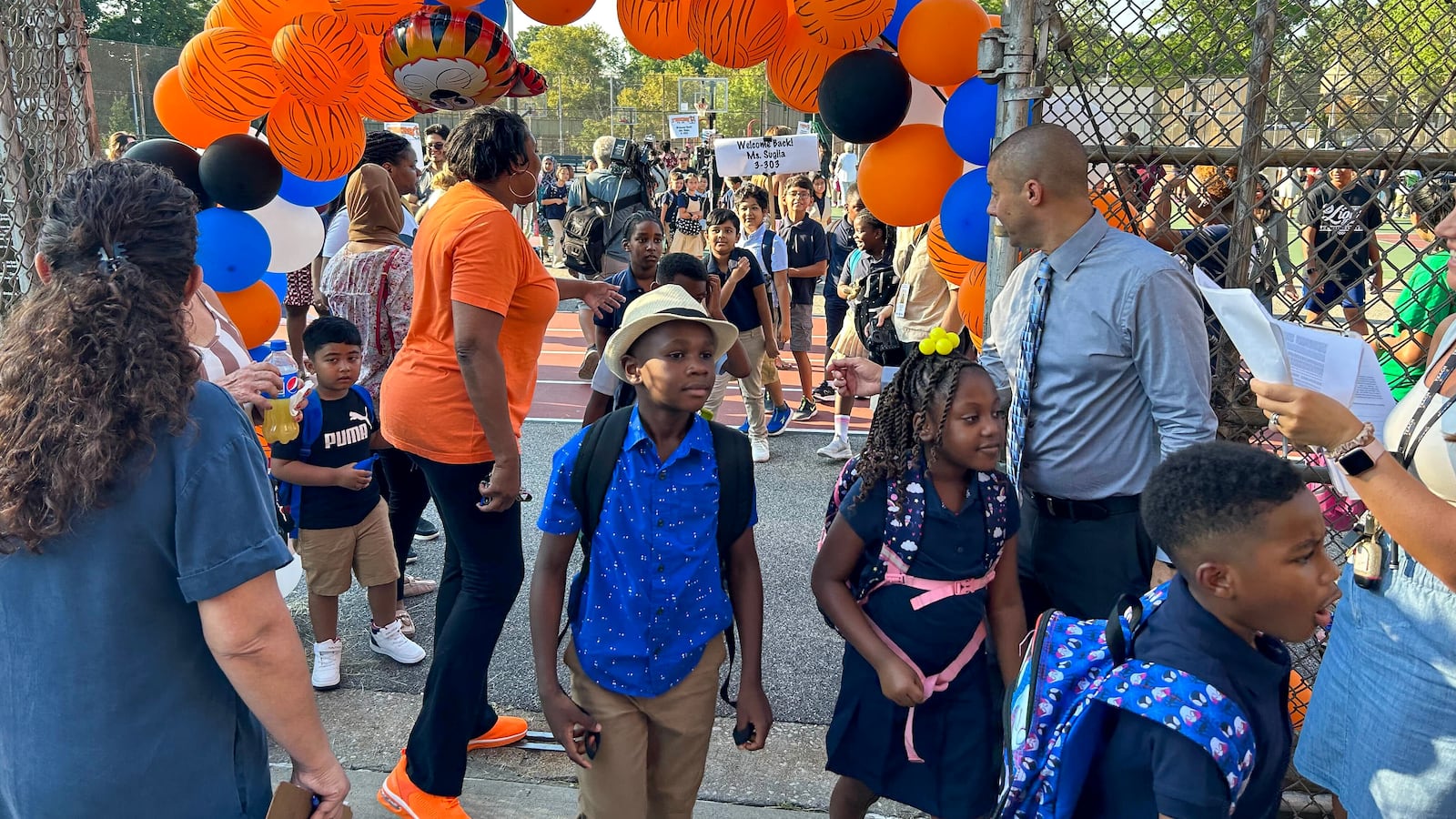Sign up for Chalkbeat New York’s free daily newsletter to keep up with NYC’s public schools.
Bronx student Avery Collazo began the school year on Thursday with an annual tradition: donning a bright blue T-shirt proudly exclaiming, “First Day of Second Grade.”
“He likes to stand out, to be a little different,” said Avery’s dad, Albert Collazo, who also brought a uniform shirt just in case.
The family joined dozens of others dropping off their children in the P.S. 121 schoolyard as the first day of school for New York City’s nearly 900,000 students brought out an array of emotions.
Some caregivers shed tears as they watched their kids walk inside the school building. Some kids smiled confidently; some shyly. There was also some sweat. High temperatures prompted a National Weather Service heat advisory, and the Education Department directed schools to limit outdoor activities after 10 a.m. Some educators and parents reported broken or non-existent air conditioners while some families were also concerned about overheated students on school buses.
Avery is enrolled in P.S. 121’s “gifted and talented” program, which pulls students from different neighborhoods. His mom, Elida, praised the city’s move to expand such programs, calling it “a great opportunity for a lot of other children.”
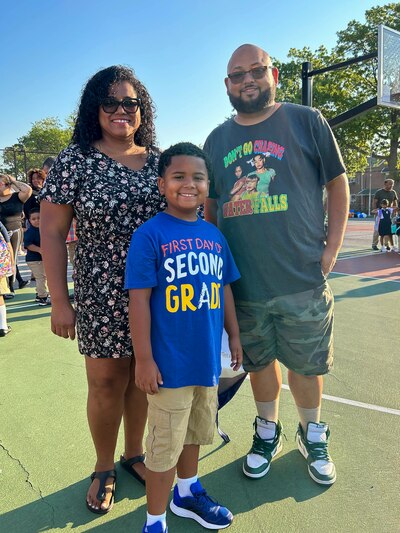
Because the family has to travel outside of their zoned school to bring Avery to the program, they rely on a yellow school bus for transportation. Even though school bus drivers vowed to stay behind the wheel this week, families were still on edge about a possible strike, which could affect an estimated 86,000 students, or more than half of the children who ride yellow school buses.
“We’re definitely hoping no strike happens,” Collazo said.
For P.S. 121 mom Phyllis Moore, the new school year represented a fresh chance to get involved in her daughter’s education following her recovery from a stroke last year.
“I’m ready to be here, to get involved, to be on the school board, to do what I need to do,” said Moore. “We’re excited.”
Her daughter Lanyah, a fourth grader, has been in the school since kindergarten. She was excited to return to school with more age and experience, she said, but the 8-year-old was still nervous to find out who her teacher and classmates would be.
Schools Chancellor David Banks joined Mayor Eric Adams at P.S. 121, in the Bronx’s District 11, which is one of the districts in the first wave of the NYC Reads initiative. In a major shift in how the nation’s largest school system teaches its youngest children how to read, elementary schools in 15 of the city’s 32 local districts must switch to one of three literacy programs this year, with the rest following next year. District 11 selected EL Education, a curriculum that some schools in the area had already implemented.
“What I am going to be laser-focused on is ensuring every single child in the school system is on grade level no later than third grade,” Banks said. “The broader issue is, for even kids who don’t have dyslexia, they can’t read. And that’s because we haven’t taught them properly how to read.”
The push to change literacy instruction comes after years of attempts to improve the city’s middling reading scores — and after a widely used curriculum, which focused heavily on independent reading without enough explicit phonics instruction, was largely discredited.
Outside of P.S. 165 in Brownsville, Brooklyn, most parents said they hadn’t heard about the city’s curriculum mandate. The school, along with every elementary campus in District 23, is required to use a curriculum called Into Reading — by far the most common program that superintendents have mandated.
Sherifa Adams said her 6-year-old daughter Kaydence was already picking up reading skills, and Adams has mixed feelings about the change. “It’s first grade, so she’s already used to something,” said Adams, who learned about the curriculum mandate from a reporter. “I hope that this new reading curriculum only makes it better and not worse for her.”
The school plans to hold a curriculum night next week and will share more information about the new reading program with families then, an Education Department spokesperson said.
The literacy mandate may signal a wider effort to come, Education Department officials noted. The city is already pushing such changes for early education and ninth grade algebra. Some high school superintendents have opted to implement literacy instruction mandates on their own accord.
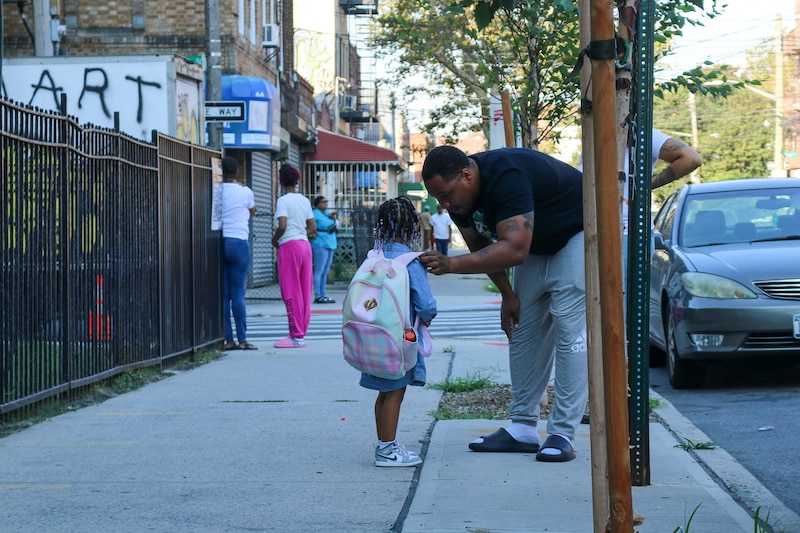
Meanwhile, the city also continues to grapple with how it will accommodate the influx of children from asylum-seeking families. Banks announced Thursday that the city is hoping to address the chronic shortage of bilingual teachers by reducing a bureaucratic hurdle. For educators who are already certified in bilingual education but teach other areas, they will no longer lose tenure by switching subjects, Banks said. The move would affect about 500 teachers.
Despite the ongoing challenges, the first day of school also marked the tremendous progress that many of the newcomers have made since arriving last year.
At I.S. 93 in Ridgewood, Queens, one student who arrived in the country six months ago speaking no English made enough progress to enroll in an honors dual-language class this year. He was part of a team that won a classwide engineering competition Thursday, said his teacher Sara Hobler.
“This sort of thing is why I teach,” Hobler said. “It makes you take a step back for a moment and remember why you go through all the difficult parts of the job — for those looks on those kids’ faces when they realize they’re going to thrive.”
Busing woes, even without a strike
It has become all too common for students to have problems with yellow school buses, particularly on the first day of school. This year was no exception, as union officials continue negotiating with the city over a new contract. There were nearly 1,300 bus delays reported on the Office of Pupil Transportation’s website as of 4 p.m.
Brownsville mom Anika Smith said she received limited information about bus service and had yet to receive pick up and drop off times, even though her second grade son is entitled to transportation because of a disability.
Smith accompanied her son on Thursday to greet his teachers. Though the family lives a few blocks away from school, the mom said ongoing disruptions would be a “catastrophe,” forcing her to scramble to find relatives to help with transportation or rearrange her nursing shifts at a local hospital.
“I’m gonna have to take off a couple of days, switch around my hours,” Smith said. “I lose wages. I could get a write up … the hospital’s already short staffed.”
Outside her son’s school, P.S. 165, a staff member told a small group of families gathered in the schoolyard about the city’s contingency plans, including MetroCards or rideshare services for children with disabilities, those in temporary housing, or children in foster care.
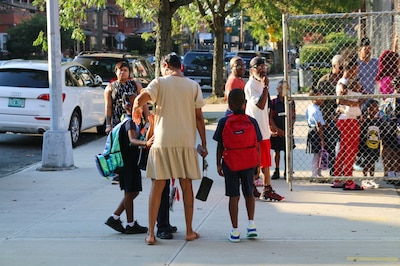
Naomi Peña, a mother of four children with dyslexia and co-founder of a Bronx-based literacy program, said her son’s bus arrived at their home just 10 minutes before his school was scheduled to start. By the time he arrived on campus, he was more than two hours late, meaning he missed his entire morning literacy block, she said.
The late bus – along with her daughter’s class having no working air conditioning – led to a disappointing first day of school, Peña said.
“It’s frustrating because I am just one parent that experiences these things, but it’s part of a larger ecosystem of hundreds of thousands of parents,” she said. “It shouldn’t happen. It shouldn’t. Our kids deserve better, especially on their first day.”
Enrollment, mergers, and navigating the system
Over the past five years, K-12 enrollment has fallen by more than 120,000, which can have big consequences for schools since funding is tied to student headcount.
At Brooklyn’s P.S. 165, for instance, enrollment dipped below 200 students last year — one of a growing share of elementary schools in central Brooklyn and across the city below that threshold. Though small schools can be more expensive for the city to run on a per-student basis, several parents said there are benefits, too.
“With a small school environment, she will get the help that she needs,” said Crystal Salgado, referring to her 6-year-old daughter, Cianna. “The teachers actually know the kids.”
For her part, Cianna was so excited to be back at school that she zoomed past her mother into the schoolyard. She said she was most excited for lunch, preferably pizza.
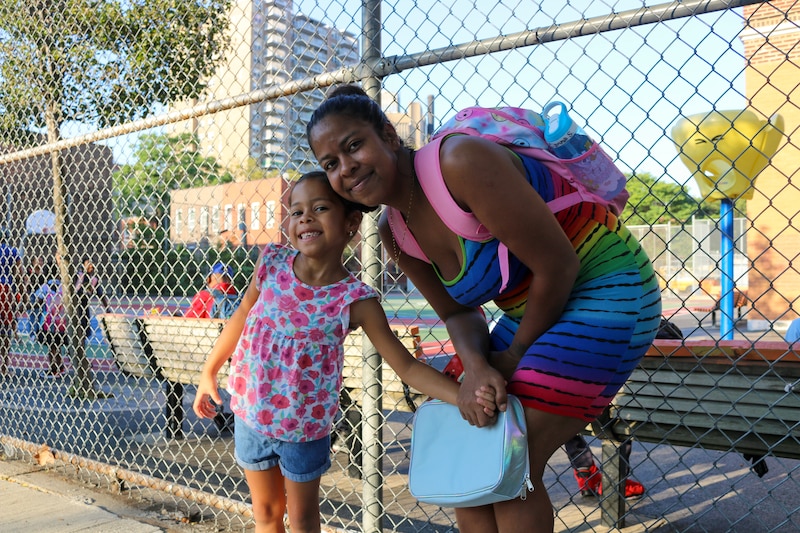
Some school communities began to see controversial mergers last school year, like one at Lafayette Academy, which joined with West Side Collaborative.
Despite opposition from both of these small Upper West middle schools, the proposal passed. Morana Mesic, a former PTA president at West Side Collaborative who opposed the merger, said her seventh grade son cried last night as the realization hit that he wouldn’t be returning to the small school that had felt like home. Instead, he’ll be attending West End Secondary School, a much larger 6-12 school on the Upper West Side that he transferred to over the summer.
“He’s going into a whole new environment all over again, so he did have a really emotional reaction,” she said. “He was anxious, frustrated, and scared, saying, ‘I don’t know if I’m gonna be accepted.’”
Just over 30 blocks north, on the Upper West Side campus Lafayette shares with two other schools, families fanned into a crowded street, greeted by welcome signs and an energetic traffic conductor shouting, “Good morning! Good morning! Happy first day!”
Some students matched the excitement as they approached the building.
One Manhattan School for Children student said she couldn’t wait for “math, seeing my friends, writing, and anything I learn.”
Nearby, Jeanelle and Zaki Jarrah, stood next to their eighth-grader Finn. The family is new to the city, having just moved from Flagler Beach, Florida, a few weeks ago.
They said they were looking forward to their son developing closer connections in a smaller school environment. But they didn’t have a clear idea why they picked the Manhattan School for Children.
“We have absolutely no idea what we’re doing,” Jeanelle Jarrah said, laughing. “The school system here is so overwhelming.”
Michael Elsen-Rooney is a reporter for Chalkbeat New York, covering NYC public schools. Contact Michael at melsen-rooney@chalkbeat.org.
Alex Zimmerman is a reporter for Chalkbeat New York, covering NYC public schools. Contact Alex at azimmerman@chalkbeat.org.
Julian Shen-Berro is a reporter covering New York City. Contact him at jshen-berro@chalkbeat.org.
Amy Zimmer is the bureau chief for Chalkbeat New York. Contact Amy at azimmer@chalkbeat.org.

